The begonia is a classic houseplant garden gem, and this popular plant can bloom year-round in ideal conditions. Begonias are one of the most beautiful, visually interesting plants that can grow well indoors. Begonias are a favorite plant because of their diverse leaf sizes, shapes and colors, and myriad growth habits. Their hardy and beautiful blooms can transform your outdoor or indoor garden space into beautiful and authentic. These plants have colorful flowers and lush foliage.
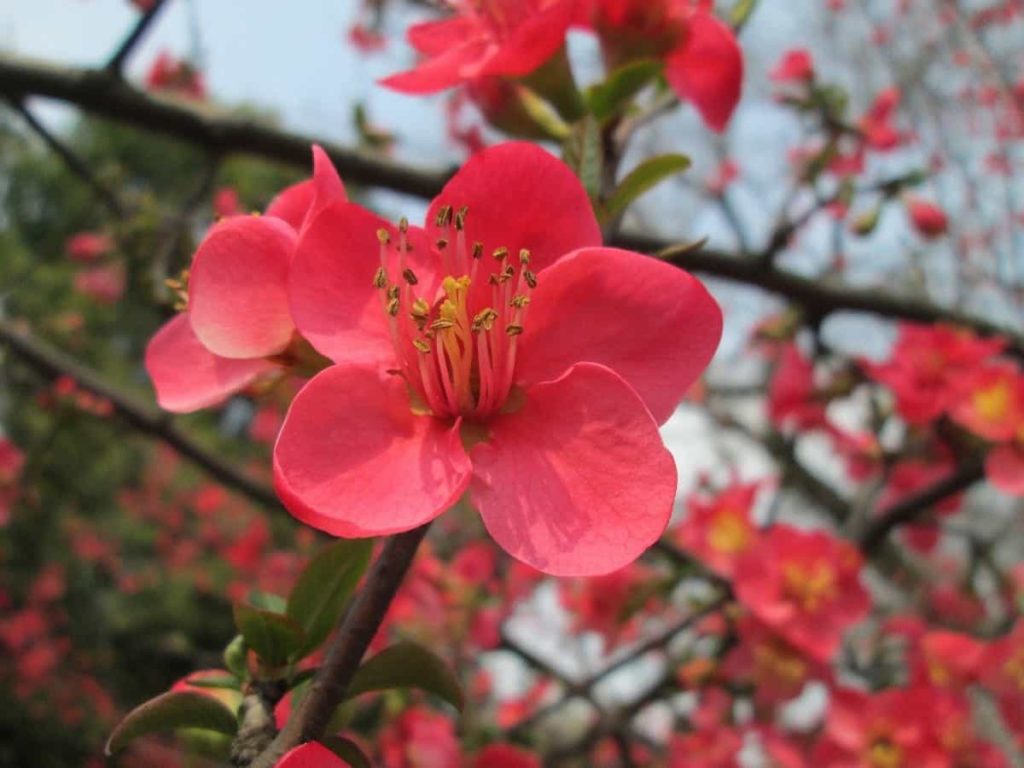
Begonias are a genus of flowering plants with over 1,000 varieties. Some varieties are well suited for hanging baskets, window boxes, or flower beds, while others grow best when potted and kept indoors. Begonias are comparatively easy to grow and will continue to flower all summer when proper care has been taken. Begonias are tender perennial blooms with colorful flowers and foliage. Begonias can be grown outdoors in pots, on the ground in filtered light, and in moist, well-drained soil and grow as annuals or indoors as houseplants.
How to plant and care for Begonias
Begonia plant types
The Begoniaceae family is the largest flowering plant group, with more than 1,200 known varieties. It is relatively easy to identify begonias because all varieties fall into five main types, sorted by their root systems.
Tuberous begonias
Tuberous begonias can be grown from potato-like tubers. These plants are considered popular bedding plants due to the fast growth of their blooms that last from early summer to late fall. These plants can grow to a height from a few inches to over a foot. Depending on the species, they will produce single or double blooms that reach up to 6 inches in diameter.
Rhizomatous begonias
These plants are well known for striking foliage than blooms. Rhizomatous begonias are differentiated from others by roots resembling knobby and ground parallel stems that creep along the soil surface. The leaves on this variety of begonia can be colorful, ranging from white and soft yellow to purple, green, and red, often in exotic combinations and patterns.
In case you missed it: Kansas Vegetable Planting Calendar (KS): Month Wise Guide for Fall, Winter, Spring, Summer, Zone 5, Zone 6, and Zone 7
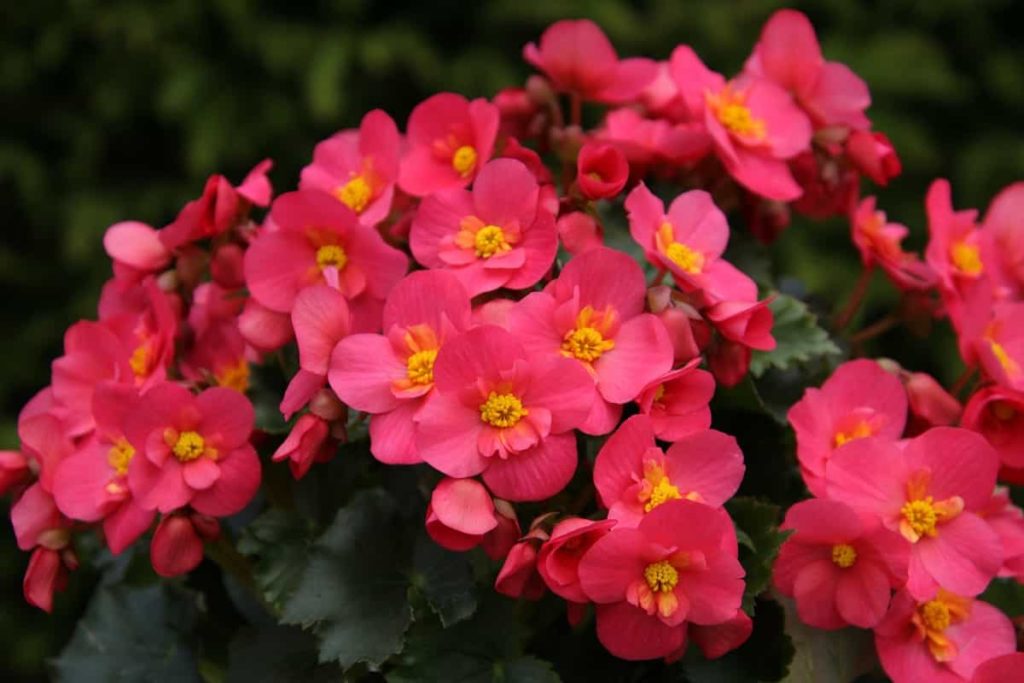
Fibrous or wax begonias
Fibrous, more commonly known as wax begonias, is one of the classic garden varieties of begonia. These beautiful flowering plants also come in various colors for bedding plants or container plants. These blooms are best to plant in shaded window boxes and hanging baskets. Select a variety of fibrous begonias that develops long stems that will spill over the edge in a showy burst of color.
Rex begonias
Rex begonias are technically rhizomatous begonia variety, but with over four thousand cultivars, they get their category in flower shows. Rex begonias have beautiful, multicolored leaves in shades of silver, maroon, burgundy, purple, orange, and red, often with an iridescent pattern. All the cultivars in this variety are descended from the species begonia rex species that was crossed with other types of rhizomatous begonias.
Cane begonias
With cane begonias, the new shoots can grow straight up first and only start branching after reaching a certain height. They will grow tall before branching, but once they do, they can grow into a pretty shrubby plant. This begonia is easy to grow and perfect for new gardeners who need some confidence.
Cane begonias are well suited for garden areas, as well as for indoors and in greenhouses. And they are very easy to propagate from stem cuttings and are grown for their foliage and flowers. There are about 81 varieties classified as cane begonias and almost two thousand cultivars.
Popular begonia species cultivars
Charm begonia
This popular wax begonia variety is a compact bedding plant growing to less than a foot, with various colored leaves and pink flowers. Charm begonia will grow straight with succulent stems. They have many single flowers that are everblooming and in pale pink. The foliage looks very attractive and various colored.
This plant can take filtered light but can take some sun in winter. Soil should be moist but not soggy. Begonias can be grown very well in peat-based compost also. These plants like to grow in humid weather but do not like cold weather. Pinching tips and pruning outer stems during the growing season gives a bushier plant.
Dusty rose begonia
Dusty rose is a beautiful begonia plant with having pink color shade. It looks lighter on the inner petals and then darker around the margins. The flowers are all the same ruffled flowers that sit upright. It forms a clean mound and would fill a small pot superbly, or it would look great as part of a mixed-shade container.
It would also add a great authentic look to a shade garden with its beautiful carnation-like ruffled flowers. It is the best type that takes more sun, giving it more garden versatility. Dusty rose bursts with blooms when grown in the sun with light shade and rises to a mounded plant about a foot in diameter.
Olympia red
Olympia red begonias have many small red blossoms with yellow centers that sit on top of waxy green, oval-shaped leaves. These begonias can withstand sunny conditions as long as they get enough water. They look great when planted in borders and masses in garden beds. The blooms last a long period, so hardly any deadheading is required.
In case you missed it: How to Plant and Care for Hydrangeas: Steps to Grow Hydrangeas for Beginners
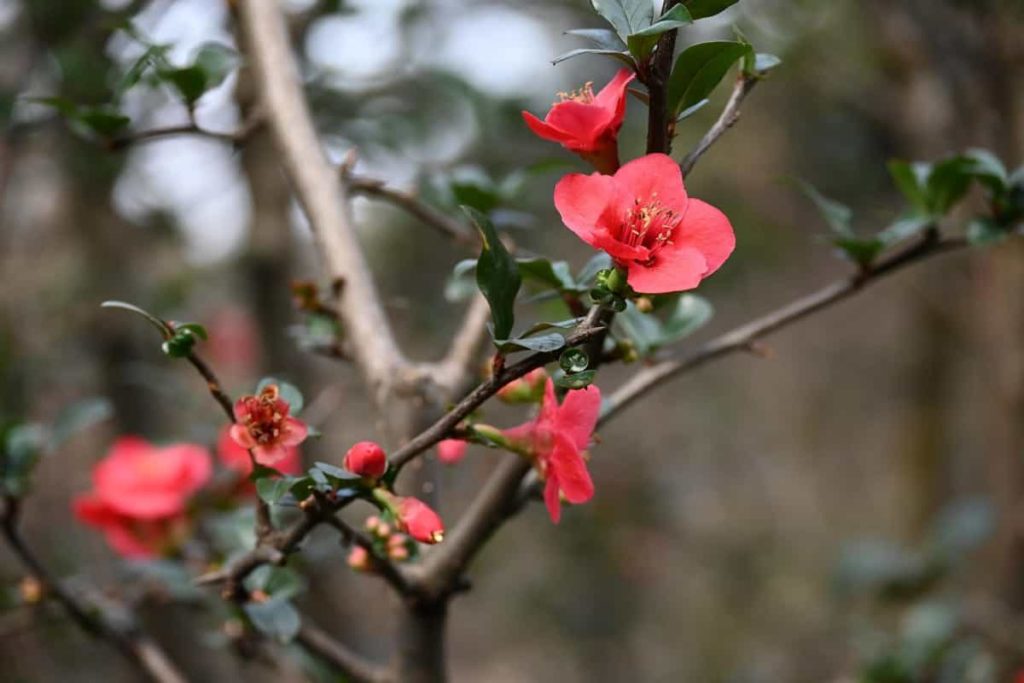
On top fandango
On Top Fandango is a beautiful dual-color begonia, white with light pink blushing margins. The blossoms of these plants are large, fluffy, and rose-like. This elegant type looks great in pots. Complement the blossoms with other white and light pink flowers for a beautiful arrangement.
Richmond begonia
Richmond begonia is considered a shrubby plant that grows to 2 feet tall by an equal width. These plants have red stems holding attractive semi-succulent and glossy oval-shaped leaves that are dark green with red undersides and red scalloped and toothed margins. In frost-free locations, the salmon-pink flowers will bloom throughout the year.
Planting these plants in well-drained soil and bright shade or part sun with more intense light brings out the best reddish colors. This begonia with pink and white blooms will grace shade-placed hanging baskets and containers.
Mocca yellow begonia
A spectacular upright begonia having beautiful dark, heart-shaped foliage and large and colorful double blooms is produced throughout the season. These plants grow well in hot and humid conditions and are great for containers, hanging baskets, or garden landscapes. This begonia is an herbaceous annual with a heap form. Its medium texture mixes well into the garden.
Non-stop Orange
Bring a festive look to shaded terraces and flowerbeds with orange non-stop begonias. They produce many bright orange colored and double flowers for months. Orange non-stop begonias begin flowering in midsummer and continue flowering until the first fall frost. The medium-sized, perfectly formed, double flowers grow on strong plants with a real dwarf growing habit, making them wind resistant. They start flowering very early, and flower buds appear with the first leaves. They look impressive when planted as focal points or in terrace tubs in groups.
Red tempest begonia
This begonia foliage has many flowers, with dark green veins and a purplish tint at the center, all under pink flowers. Red tempest begonia is a tall rex type boasting large, maple-shaped spiral leaves painted in a beautiful combination of colors. A reddish-purple heart at the center is surrounded by silver, attractive dark green veining, and a dark border to emphasize the shape of each leaf.
Pink flowers add to the striking foliage display in summer and autumn. These plants will grow to a maximum height of 100cm and spread up to 35cm wide. These begonias are great shade-tolerant houseplants, offering unique and good-looking foliage and flowers that appear periodically throughout the year. They can be shifted outside during the summer months.
Cocktail series begonias
The cocktail series of wax begonia has thick reddish maroon leaves. They can withstand more sun than the green varieties. Cocktail rum will look great planted as a mass next to light pink flowers, such as rocket orchid snapdragons. Or near a real chartreuse leaf plant, like wasabi coleus. Try using it in a pot with pink flowers and chartreuse foliage. It is a great little flower to play with and create eye-catching combinations.
Soil requirements for begonias
Generally, begonia can be well grown in airy, well-draining, acidic soil with proper moisture retention. The pH value generally ranges from 5.2 to 6.0 pH. Begonias prefer well-drained soil with sandy and clay. Begonias are most susceptible to stem and root rot, so begonias must have a proper drainage system. Ensure that the begonias are not exposed to overly wet soil by choosing a lighter potting soil with extra perlite or by creating a mix of peat moss, perlite, and potting soil. Ensure to use equal parts of each soil type.
Planting begonias
Gardeners have many begonia choices, including hanging baskets and hardy begonias. These begonia flowers come in various bright colors, including red, yellow, pink, orange, and white. Begonia leaves are usually green, but some varieties have darker leaves. The foliage is often large and sometimes sawtoothed. Many begonia plants grow to a maximum height of 12 inches, but some begonias grow larger.
When selecting begonias, note their height and spread to determine what containers to plant them in or how many you will need for window boxes or flower beds. For best results, plant the begonia plants in the spring. Since most do not like direct sun, most begonias will tolerate a bit of morning sun or filtered sunlight. Do not plant them outdoors until the weather warms and nighttime temperatures because begonias are tropical plants.
If you plan to plant begonia tubers in the garden, plant them indoors and transplant them to the garden after the weather warms. Plant the begonia tubers with a spacing of 10 to 12 inches apart. Transplant after all frost has passed, as they are extremely frost tender. First, select a location that gets partial shade or filtered sunlight; morning sun and afternoon shade are the best, especially when it is hot. Try a dark-leaved type or one that specifies improved sun tolerance for sunnier locations.
In case you missed it: Indiana Vegetable Planting Calendar/Guide (IN): Month Wise, Fall, Winter, Spring, Summer, Zone 5, and Zone 6
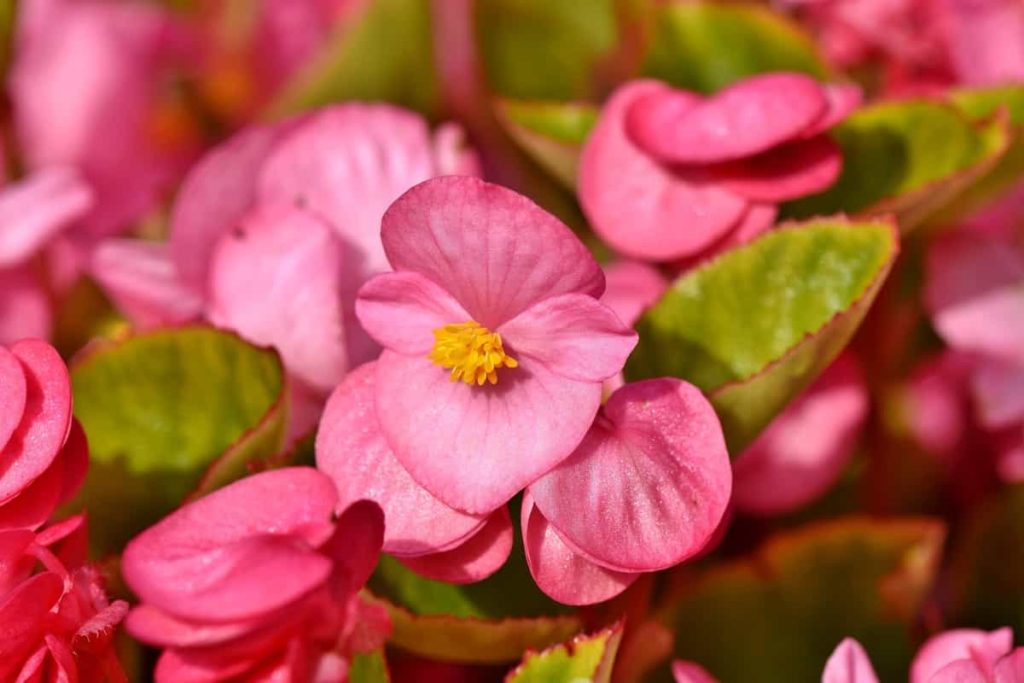
Plant the begonias where they will have good air circulation to prevent powdery mildew. Plant wax begonia transplants with a spacing of 6 to 8 inches between them and others according to their mature size. Tubers can be grown indoors by placing the tubers in a shallow tray with moist potting mix. Place the tray in a room and water enough to moisten the potting mix. Tubers should sprout in about four weeks and be moved to an area with bright light once they sprout about an inch tall. Only plant begonias outdoors when there the threat of frost has over.
Growing begonias and care
Rex begonias can demand the right amount of water, food, and humidity. These requirements will vary; the only way is to watch it once to know what your plant wants, and it has adjusted to its new surroundings. If it is flourishing, continue with the caring action you were doing. If it is droopy, adjust the light and water. Finally, you have to figure out the right balance.
Ensure the garden beds or containers meet the requirements of the begonia. Alternatively, if the outdoor conditions are too cold, consider growing as a houseplant or in an outdoor container that can be moved indoors in cooler weather.
Light
Wax Begonias, occasionally called bedding begonias, are common in flower beds and known for their red, pink, or white flowers. They can withstand extended direct sunlight compared to other types. The tuberous begonia likes more shade and less heat and is prized for its larger flowers, bright colors, and foliage. Some are even fragrant. As begonias are tropical plants, they prefer areas that receive a lot of light but also enjoy protection from the sun. An ideal landscape spot is where the plants will get plenty of morning sunshine and shade in the afternoon.
Humidity
Humidity or water content in the air is also important in Begonia care. These plants can be grown well at higher humidity levels because they come from tropical areas with a higher level of humidity. The fuzzy-stemmed rex begonias and some tuberous outdoor varieties need the highest humidity of all the Begonia types.
Watering
When watering begonias, it is important always to keep the soil moist but not soggy. It is best to water the begonias every few days or when the soil begins to dry out. Begonias are more susceptible to rotting if the soil is too wet or the plant is overwatered. Take care not to over-water, which will result in dropped leaves and other signs of rot. Allow the soil to dry 1-2 inches from the topsoil between watering. It is suggested to water around the tuber instead of directly top it to prevent water from pooling in the tuber.
Feeding fertilizers
Begonias have a great hunger for nutrients and are considered heavy feeders, so frequent fertilization is necessary for them to thrive. A high nitrogen fertilizer must be fed to the plants every two weeks early in the spring to ensure healthy growth and blooming later in the season.
Always read the package and dilute fertilizer, never fertilizing in the fall and winter. Generally, begonia requires a slow-release balanced fertilizer every two weeks during its growing season. They also prefer organic matter or compost with extra perlite and peat moss. The begonia plant does not go into dormancy during winter.
Pruning
Begonias make a great choice to decorate the shaded areas of the garden or house, but they require pruning to control their spread, keep their foliage thick and avoid an overgrown look. Common begonia varieties include tuberous cane, Semper Florens, rex, and winter-flowering begonias. Many varieties can be grown outdoors, but you can also grow them as annuals or indoors in colder climates. Prune begonia plant to shape it and help it flourish. After planting, pinch off new growth for a few weeks.
Remove the ends of small stems that branch off the main stems using a finger and thumb. This small stem cutting will encourage several new stems to sprout in place of each stem you pinch. Also, pinch off the flower buds of begonias which will make the plant produce additional blooms. Finally, inspect the plants for damaged or diseased areas and regularly check the begonia for discolored leaves and stems.
Separate dead or diseased parts with shears or scissors. Cut off the discolored stem or leaf just below the start of the brown area. Cut off the entire stem if there is a large brown area. Ensure not to damage the main stem. Remove the dead leaves and pruned stems from the floor immediately, as diseases may spread from them into the healthy plant.
In case you missed it: Connecticut Vegetable Planting Calendar (CT): Month Wise, Fall, Winter, Spring, Summer, Zone 5, Zone 6, and Zone 7
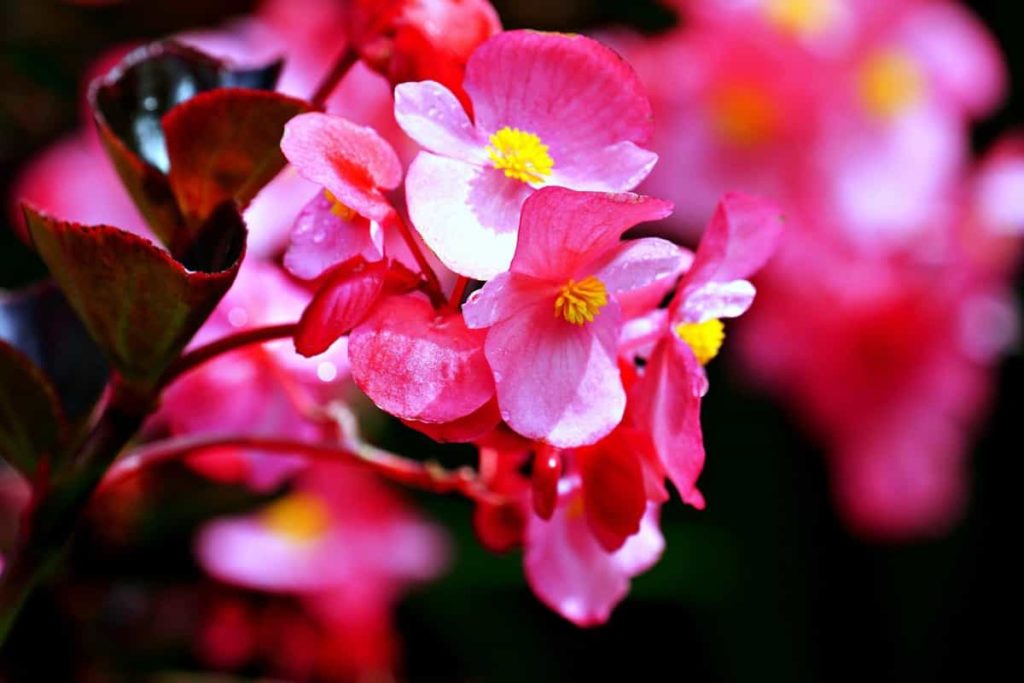
Prune leggy stems with sharp shears or scissors. Leggy stems are plant parts that grow outwards above the desired shape. They can detract from the plant’s aesthetic appeal and drain energy from other parts of the plant. This step is very important if you have perennial begonias, which come back year after year.
Mulching for begonias
Mulching should be carefully done as begonias are susceptible to rot due to wet conditions. Use husk mulch around plants to preserve soil moisture and prevent weeds from growing. Keep the plant mulched to maintain moisture at the roots. Two to four inches with organic matter like composted leaves is a good depth for mulching. While mulching, keep it a few inches away from the begonia stems to prevent them from rotting.
Growing begonias in containers or pots
Begonias will grow at home in a pot, like in a garden. To grow a begonia in a pot, you need to allow for growth, so choose a pot double the width and depth of the plant. Gently remove the begonia from its previous container or bed, gently tease the roots, position it in the pot, and backfill around it. Water the pot or container planted plant to reduce the transplanting shock. Feed with fertilizer which helps the plant root growth.
Repotting rex begonias each spring will ensure they have plenty of soil to grow in, but they like to be a little bit pot-bound. Large and gangly plants can be pruned into shape. Rotating potted begonias will keep the plants full and stocky and will get sunlight equally.
Propagating begonia plants
From seeds
Most begonias are very easy to raise from seed, easy to care for, and easy to love. These plants fill baskets, window boxes, and flower beds all summer with non-fussy blooms. They also make shaded areas pop with color and vibrancy.
- First, choose the begonia seed variety and take a container that does not have drainage holes at the bottom.
- Fill the container no more than half with the moistened and potting mix.
- Scatter the seeds over the top of the soil, spreading them as evenly as possible, and do not bury the seeds.
- Expose this container to low or ambient light and temperatures that are not too hot or too cold.
- Check the container daily for signs of life, starting around halfway into the second week.
- Once the seedlings are observed from the seeds, transplant them into separate pots after some days.
From cuttings
Taking a branch cutting is probably the well-known way to propagate a houseplant. Many of the begonias have cane-like stems that leave sprouts. The plant will easily regrow from stems, so snip off an inch or two with some leaves attached. It does not have to be the tip of the stem; any piece 2 inches or up will work.
Taking a leaf cutting is a technique unique to Begonias. Just snip a healthy, large leaf where it meets the leaf stem. Taking a rhizome cutting is similar to a stem cutting, except you do not necessarily include leaves. Rhizomatous begonias regrow very easily that you can cut a rhizome into 2 inches pieces, and as long as the parts have nodes, they can have the capacity to grow leaves and roots.
In case you missed it: Idaho Vegetable Planting Calendar/Guide (ID): Month Wise, Fall, Winter, Spring, Summer, Zone 3, Zone 4, Zone 5, Zone 6, and Zone 7
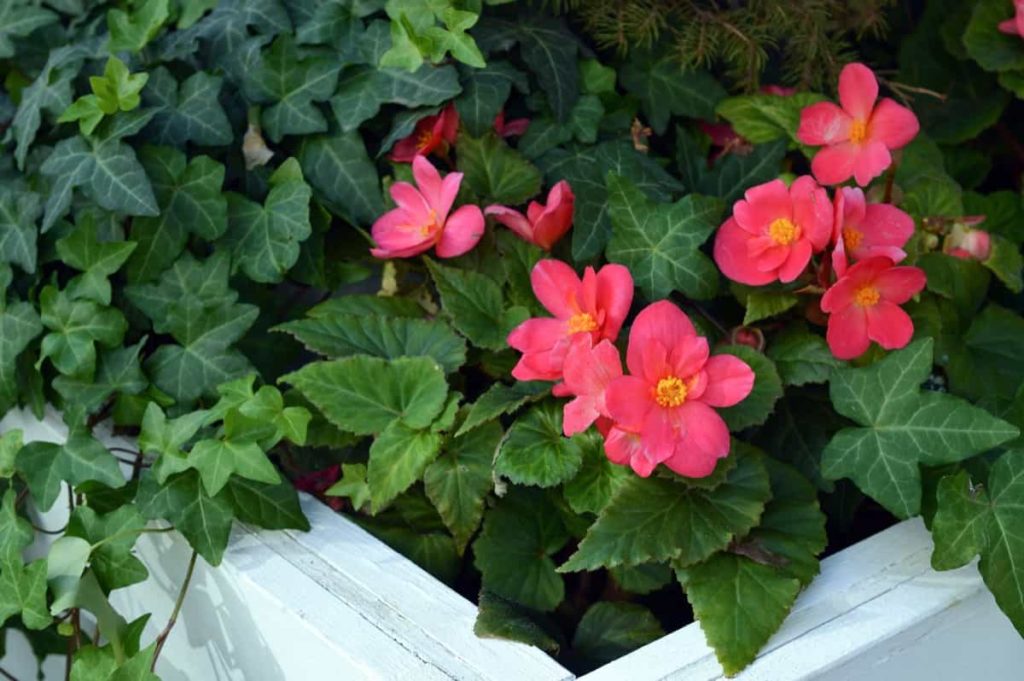
Pests and diseases in begonia plants
The biggest problem with begonias is their susceptibility to rotting if exposed to poor drainage or overwatering. Botrytis rot is one of the common fungal diseases that attack begonias. Use potting soil with extra perlite to promote proper drainage. In the garden, begonias are generally grown in sandy loam soil.
Powdery mildew is another fungus disease that can attack begonias, forming stubborn white spots on leaves and flowers, causing them to be yellow and drop prematurely. Try spraying Serenade organic fungicide on the plants to prevent mildew growth. This spray work best if used as a preventive. Whiteflies and mealybugs sometimes will attack begonias, especially on begonias that are growing indoors. Spray insecticidal soap to kill white flies, and dab mealybugs with a cotton swab drenched in rubbing alcohol.
- Profitable Village Farming Business Ideas in 2024
- High-Yield Aquaculture: Fast-Growing Fish for Farming
- Effective Fish Pond Construction Techniques for Beginners
- Irrigation and Water Management in Pineapple Farming
- Blossom to Harvest: Mastering Flowering and Pollination in Papaya Farming
- Pig Fattening Essentials: From Selection to Sale for Beginners
- Raising Wagyu Cattle: A Complete Guide for Premium Beef Production
- Soil Types and Their Water Holding Capacity
- Optimizing Irrigation Schedules for Coconut Groves for Enhanced Yield
- Espresso Your Garden: Coffee Grounds for Healthier Acid-Loving Plants
- The Best Soil Mix for Snake Plants: How to Mix Your Own Snake Plant Soil
- Green Thumb Success: Expert Tips for Cultivating Greenhouse Beans All Year Round
- Bloom All Year Round: The Ultimate Guide to Indoor Hyacinth Care
- Eco-Friendly Gardening: How to Make Liquid Fertilizer from Kitchen Waste
- Ultimate Guide to Grow Anise in Pots: Explore Seed Propagation to Harvesting
- Guide to Raising Chester White Pigs: Discover Breed Facts to Growth Management
- Mastering the Elegance: The Ultimate Guide to Weeping Cherry Tree Care, Planting, and Maintenance
- Ultimate Guide to Planting Garlic in Grow Bags: Growing Strategies for Beginners
- How to Fix Spider Plant Leaf-Related Problems: Natural and Organic Remedies
- 10 Reasons Why Your Tulsi Plant is Shedding Leaves: Home Remedies and Solutions
- Optimizing Growth and Yield: The Advantages of Palm Bunch Ash Fertilizer
- Utilizing Neem Oil Extract as a Natural Pesticide for Hydrangea
- From Soil to Harvest: Various Ways in Which Farmers Can Use AI Tools
- Steps to Encourage and Induce Citrus Flowers: A Comprehensive Guide
- How to Fix Snake Plant Leaf-Related Issues: Natural and Organic Remedies
- Transform Your Garden into a Fragrant Oasis with Raat Ki Rani (Night Blooming Jasmine)
- Discover the Ideal Chicken Breeds for Philippine Farms
- How to Create a Poultry Egg Farm Business Plan for Profits
- Grow Lemon Cucumbers Like a Pro: Insider Techniques for Bountiful Yields
- Ultimate Guide to Caring for Your Pink Princess Philodendron: Tips for Thriving Variegation
- Areca Nut Profit Per Acre: Calculating Yield and Cost of Cultivation
- How Kaveri Chicken is Becoming a More Profitable Breed in Indian Backyards
- Transform Your Barn: 9 Steps to Convert a Horse Stall into a Chicken Coop
- Exploring Suffolk Sheep Disadvantages with Limitations and Challenges
- Guide to Solving Potted Lemon Tree Problems: How to Revive Lemon Tree in Containers
- Steps to Encourage Female Pumpkin Flowers: Best Strategies for More Flowers and High Yields
